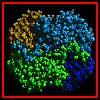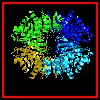
 |
|
|
Quaternary Structure - Multimeric Enzymes
This page describes some further examples of multimeric enzymes (some others are described in the overview of this Section. Enzymes are biological catalysts, which mediate a vast number of reactions in the biochemical pathways of life. Apart from some RNA molecules which have been relatively recently shown to have catalytic activity (ribozymes), all enzymes are proteins. They are highly specific in the reactions they catalyse, and bind their substrates by non-bonded interactions (refer to the appropriate page in Section 7 of the course). The catalytic regions of the enzymes which bind the substrates are called active sites. In some cases, oligomerization is a requisite for the existence of a complete active site; make sure you have read the overview of this Section, which describes two examples.
Consider how many distinct forms of M2H2 are possible.
The catalytic function does not involve interactions between the subunits, as the kinetic behaviour of, for example, the H3M form is the same as a 3:1 mixture of H4 and M4.
![]() Examine the monomer 1ldm
(260Kb) [Bbk|BNL|ExP|Waw|Hal].
Examine the monomer 1ldm
(260Kb) [Bbk|BNL|ExP|Waw|Hal].
 This diagram
shows the four subunits.
This diagram
shows the four subunits.
Here is the tetramer of the M4 isozyme, courtesy of Brookhaven PDB.


Note the similarity between the arrangements of this enzyme and lactate dehydrogenase. What type of symmetry is this? Make sure you can identify the axes of symmetry.
![]() In this case however, the
asymmetric unit of the crystal structure includes the complete tetramer
1gd1 (966Kb) [Bbk|BNL|ExP|Waw|Hal].
In this case however, the
asymmetric unit of the crystal structure includes the complete tetramer
1gd1 (966Kb) [Bbk|BNL|ExP|Waw|Hal].
Like many other structures of this fold, such as some of the other glycolytic enzymes, this enzyme is dimeric. However, there is no evidence for cooperativity of substrate binding during catalysis. Here are two diagrams indicating the symmetrical arrangement of the 2 subunits and the relative orientations of the 2 barrel axes .
![]() Examine the crystal structure
1tim (322Kb) [Bbk|BNL|ExP|Waw|Hal].
Examine the crystal structure
1tim (322Kb) [Bbk|BNL|ExP|Waw|Hal].
Click here for a diagram of a single chain, courtesy of The Swiss-3DImage Collection , who also provide several further views of the dodecamer ; and also detail of the active site .
![]() Here is the crystal structure
(the asymmetric unit is an entire dodecamer) 2gls (3.6Mb) [Bbk|BNL|ExP|Waw|Hal].
Here is the crystal structure
(the asymmetric unit is an entire dodecamer) 2gls (3.6Mb) [Bbk|BNL|ExP|Waw|Hal].
 |
|
|
Last updated 14th April '97